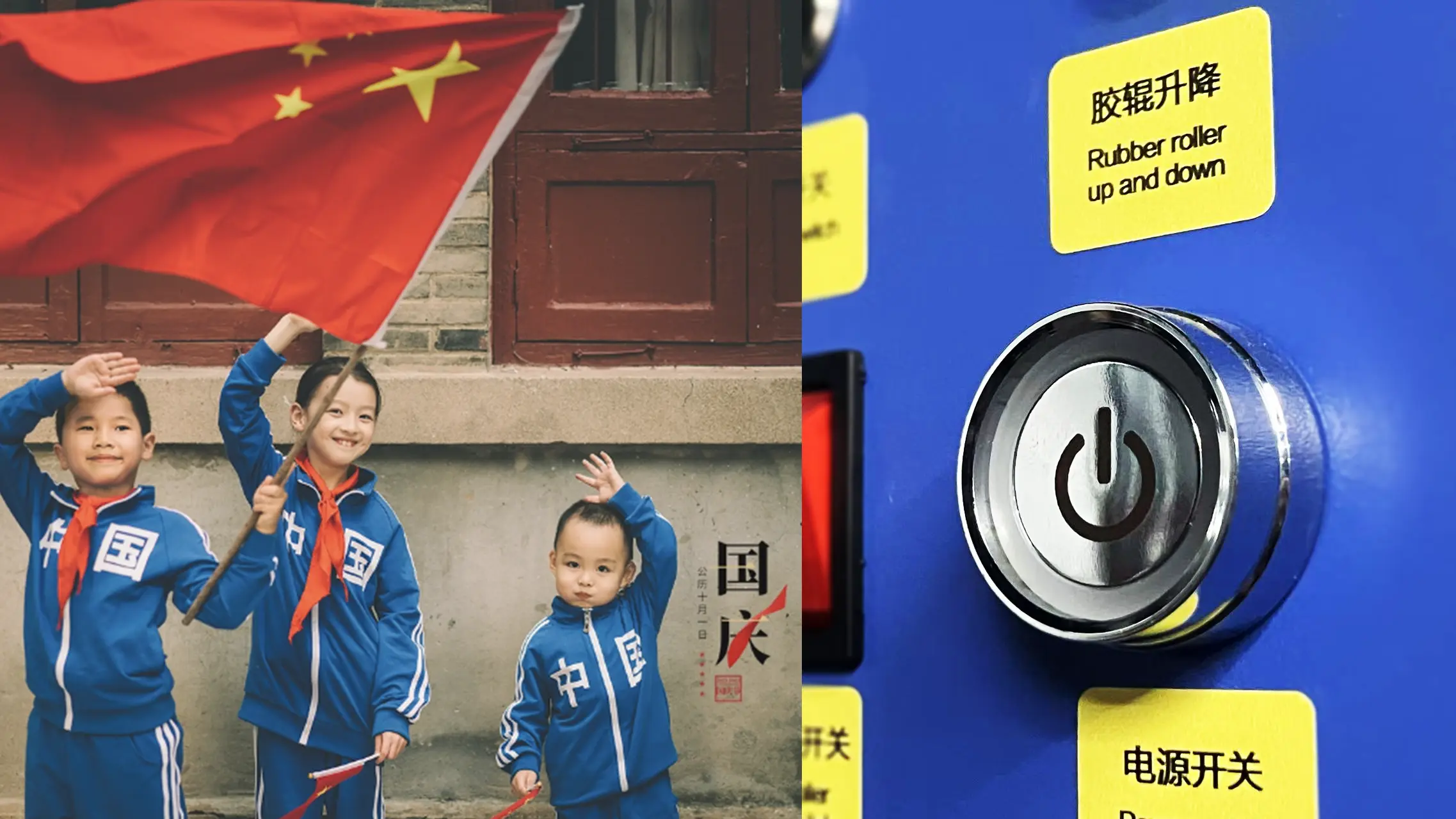Dear Keditec Equipment Management and Operating Personnel:
According to China’s National Day holiday arrangements, Keditec will enter a long holiday shutdown period from October 1st to October 8th. Considering that the core components of DTF printers, eco-solvent printers, and UV printers (such as DTF white ink systems, eco-solvent ink circuits, and UV curing lamps) are sensitive to long-term idle environments, improper protection during the 8-day holiday may easily lead to failures such as white ink precipitation clogging the nozzles, solvent volatilization causing air intake in the ink circuits, and UV lamp aging and failure. These not only affect the efficiency of starting up after the holiday but may also increase equipment maintenance costs. To ensure the safety of equipment during the holiday and reduce the risk of failures, this operation guide has been specially formulated in combination with the characteristics of the long holiday. All relevant personnel are requested to strictly implement it before leaving work on September 30th to ensure that the equipment can quickly resume stable operation after the holiday.
I. Preliminary Preparation (1 hour before getting off work on September 30)
1,Consumables Inspection and Adaptation Handling (Optimization for the Risks of the 8-Day Long Holiday)
- DTF printer: Focus on checking the remaining amount of white ink and colored ink, which need to be replenished to more than 30% (to avoid white ink particles from settling and clogging the ink path due to long-term inactivity); clean the residual ink in the ink stack and replace with a new ink absorption pad (residual ink absorbed by the old ink absorption pad is prone to drying and caking); check the inventory of DTF transfer film and hot-melt powder, remove unused transfer film from the machine and store it sealed in a dry cabinet (humidity ≤ 60%), and cover the hot-melt powder with a moisture-proof lid to prevent moisture absorption and caking, which may affect the transfer effect.
- Weak solvent printer: Ensure that the level of weak solvent ink is not lower than 25%, and replenish the special solvent to 80% capacity of the solvent bottle (to prevent air from entering the ink tube due to excessive evaporation of the solvent within 8 days); Check the solvent filter. If there is color turbidity or a pressure difference alarm, replace the filter element immediately to prevent impurities from entering the nozzle along with the ink; For ink bottles that have been used for a long time, the sealing cap must be tightened to prevent changes in ink concentration due to evaporation.
- UV Printer: Record the cumulative usage time of the UV curing lamp. If it has exceeded 600 hours (only 200 hours remaining from the 800-hour service life), it is recommended to replace it with a new lamp before turning it off (the lamp body will age faster after being idle during long holidays, which may cause failure to light up normally when turned on after the holiday). Clean the cured residual impurities in the UV ink filter, check whether the cooling fan of the UV lamp is running normally, ensure that the fan is free of dust and jamming, and avoid dust accumulation affecting heat dissipation during long holidays.
- General media handling: All models must have the media inside the machine completely removed —— For DTF printers, clean the residual hot-melt powder on the surface of the film feeding roller (sweep gently with a dry soft brush and then wipe with a dust-free cloth); For eco-solvent printers, fully retract the roll paper into the paper core, wrap it with a dust-proof film and fix it to prevent the paper core from loosening or getting damp; For UV printers, wipe the residual UV glue and ink on the platform with UV-specific cleaning agent, and store flat materials on moisture-proof shelves by category to avoid surface contamination with dust.
2,Tools and Protection, Document Preparation
- Tool list: Prepare special tools according to the model —— DTF printers require dust-free cloths, special white ink cleaning agents, nozzle moisturizing fluid, and hot melt powder cleaning brushes; solvent-based printers require 75% concentration alcohol, ink circuit cleaning fluid, and ink-absorbing cotton; UV printers require UV special cleaning agents, scratch-resistant platform cloths, and moisture-proof silica gel packs. Also prepare protective equipment: nitrile gloves (to prevent ink penetration), goggles (to prevent UV cleaning agent splashing), and dust masks (to be used when handling DTF hot melt powder).。
- Documents and Identification: Print the “Keditec National Day Holiday Equipment Shutdown Record Form”, mark “Shutdown Period: 10.1 – 10.8”, and confirm in advance the main power switch, main gate position of each printer, and the contact information of the equipment administrator (which should be posted next to the equipment); prepare identification stickers “Closed During National Day Holiday”, “Do Not Close the Gate”, and “Do Not Operate”, which will be used on the equipment body, main gate, and operation panel respectively.
II. Core Shutdown Steps by Model (30 minutes before the end of work on September 30)
1,DTF printer (core anti-white ink precipitation and nozzle drying)
- Task Termination and Software Shutdown: In DTF printing control software (such as Cadlink, CorelDRAW RIP), stop all pending tasks, wait for the current transfer film printing to complete before closing the software (forcibly closing the software or cutting off power is prohibited); exit the printer’s online mode. If there is white ink accumulation on the last printed sheet, manually use a dust-free cloth dipped in a small amount of moisturizing liquid to gently wipe the surface of the print head to remove residual white ink.
- Mo Road Deep Cleaning: Enter the “Maintenance Mode” on the printer’s operation panel. Prioritize selecting “White Ink Circulation Cleaning” (aimed at the characteristic of white ink being prone to precipitation), and run it 3 times (with an 8-minute interval between each run to allow the cleaning solution to fully dissolve the residual white ink in the pipes). Then perform “Nozzle Cleaning” 2 times, print a nozzle test page, and check that there are no broken lines or ink leakage for both white ink and color ink. If there are slight broken lines, an additional cleaning is required.
- Cooling and cleaning of heating components: Turn off the independent power supplies of the DTF heating platform and drying tunnel, wait for the temperature to drop to below 30℃ as displayed on the panel (approximately 15 minutes), and do not touch the heating parts during this period; wipe off the residual hot-melt powder on the surface of the heating roller with a dry and dust-free cloth, and blow clean the dust inside the drying tunnel with compressed air (adjust the pressure to 0.3MPa) to prevent the dust from getting damp and caking during the long holiday.
- Nozzle moisturizing and sealing: Select “Nozzle Protection Mode”, and the printer will automatically move the nozzle to the moisturizing chamber. Manually add DTF-specific moisturizing fluid (evenly cover the surface of the nozzle with a thickness of 1-2mm; too much will easily dilute the ink, and too little will easily cause the nozzle to dry out). After closing the lid of the moisturizing chamber, seal the nozzle area with a dust-proof film to prevent air from entering and accelerating the evaporation of the moisturizing fluid.
- Power-off sequence: First, turn off the power of the DTF printer’s operation panel, wait for 10 minutes (until the internal cooling fan stops running and the ink circuit pressure is balanced), then turn off the independent power supply of the heating component, and finally disconnect the main switch; Unplug the power plug (if the humidity of the equipment storage environment is > 60%) to prevent static electricity from damaging the motherboard during long holidays.
2,Weak solvent printer (core: prevention of solvent volatilization and ink path air intake)
- Task Pause and Ink Path Pressure Relief: Terminate all printing tasks in RIP software (such as FlexiSign, Onyx), wait for the roll paper to be completely retracted into the paper core, and then close the software; execute the “ink path pressure relief” command (some models need to be manually triggered on the operation panel) to release the pressure in the ink tube, wait for 5 minutes, and then exit the online state to prevent ink from flowing back and contaminating the ink bottle.
- Cleaning of the spray head and ink tube: Enter the “Maintenance Menu”, select “Ink Tube Cleaning”, and rinse the ink tube with a special cleaning solution for weak solvents twice (wait 3 minutes after each cleaning to allow the cleaning solution to fully soak the tube); then perform “Spray Head Cleaning” until the printed test strip has no residual ink spots and uniform colors. If there are blank segments on the test strip, check if the ink tube has air intake and clean it again.
- Solvent recovery and storage: Open the solvent recovery tank, pour the residual solvent (it should be poured into a dedicated waste liquid collection bucket; random discharge is prohibited), wipe the tank mouth with a dust-free cloth, then seal it, and attach the label “Do not touch during the National Day holiday”; Check the solvent volatile filter cotton. If it is saturated (the color becomes darker), replace it with new cotton to ensure the exhaust system is unobstructed and prevent residual solvent gas from accumulating in the equipment.
- Cleaning the machine body and paper inlet: Wipe the surface of the machine body and the buttons on the operation panel with 75% alcohol (to remove ink residues and fingerprints), with a focus on cleaning the crystals around the solvent evaporation port; Clean the paper scraps on the surface of the paper feed roller, and blow off the dust in the paper inlet and sensor gaps with compressed air; Check the sealing caps of all ink bottles to ensure they are tightly closed without leakage, so as to prevent ink evaporation during the long holiday.
- Power-off operation: Turn off the main power switch of the printer, wait for 8 minutes (until the internal solvent volatilization fan stops completely), then turn off the power of the solvent replenishment system, and finally disconnect the main switch; Post a sign “No closing during National Day holiday (10.1-10.8)” at the main switch to prevent misoperation by irrelevant personnel.
3,UV Printer (Core: Prevention of UV Lamp Aging and Ink Curing)
- Task Termination and UV Lamp Cooling: After stopping the printing task, keep the printer power on and wait for the UV curing lamp to cool down until the temperature displayed on the panel is <35℃ (approximately 20 minutes; turning off at high temperature may easily cause oxidation and aging of the lamp holder). During the cooling period, do not touch the lamp box shell (the surface temperature can reach above 80℃, which may easily cause burns), and at the same time, observe the operation status of the fan to ensure there is no abnormal noise.
- UV Ink Path and Nozzle Cleaning: Enter the “UV Maintenance” menu, select “UV Ink Cleaning”, and rinse the ink path pipes and nozzles with UV-specific cleaning agent (UV ink tends to cure upon contact with air, so residual ink must be thoroughly removed). After running it twice, print a test page to confirm that there is no residual cured ink in the nozzles and that the ink output is uniform. After cleaning, disconnect the independent power supply of the UV curing module to prevent ink from caking due to accidental activation during long holidays.
- Protection of the platform and light box: Dip a lint-free cloth in UV-specific cleaning agent and wipe the printing platform (to remove residual UV glue and ink, preventing difficulty in cleaning after curing); check if there is any stain on the surface of the UV lamp, and gently wipe it with a dry lint-free cloth (do not use water or alcohol, as it may cause the lamp body to crack); place 2-3 packs of moisture-proof silica gel in the light box (marked “10.8 replacement”), fix them in the corner of the light box, and avoid contact with the UV lamp.
- Equipment Sealing and Cleaning: Close all the doors of the UV printer, cover the entire equipment with a special dust cover (the dust cover must be breathable to avoid internal moisture), and paste a note saying “Closed during National Day holiday, reopening on October 9” on the inner side of the dust cover; clean the UV curing residues on the surface of the machine body (which can be wiped with alcohol) to ensure there are no sticky substances and prevent dust from adhering.
- Power outage and recording: First, turn off the independent switch of the UV curing module, then turn off the main power supply of the printer, and finally turn off the main switch; In the “Keditec National Day Holiday Equipment Shutdown Record Form”, fill in the UV lamp usage time, number of cleanings, and the placement position of the silicone bag, and mark “Check the humidity of the silicone bag before starting up on October 9th” to facilitate traceability after the holiday.
III. Equipment Protection and Emergency Response During the National Day Holiday (October 1st – October 8th)
1. Daily protection of equipment (to be carried out by the on-duty personnel)
- Dust and moisture prevention: Check daily whether the dust covers of all models are completely covered. The dehumidifying bags next to DTF printers and UV printers should be replaced once every 3 days (if the dehumidifying bags change color due to moisture absorption); The storage area for weak solvent printers should be kept ventilated (open windows for ventilation twice a day, 30 minutes each time) to avoid the accumulation of solvent volatile gases.
- Safety inspection: Inspect the equipment storage area daily to ensure that the signs “No Operation” and “No Switching On” are not falling off. Check the status of the main switch to prevent misoperation by irrelevant personnel; check if there are any fire sources around the equipment (such as holiday decorative lights, mosquito coils, etc.). Weak solvent waste barrels must be kept away from fire sources and stored in explosion-proof cabinets.
2. Emergency handling procedures
- Ink leakage: If DTF white ink or weak solvent ink leakage is found, the on-duty personnel must wear nitrile gloves and goggles, absorb the leaked ink with ink-absorbing cotton, and wipe the contaminated area with the corresponding cleaning agent (white ink cleaning agent for DTF, alcohol for weak solvent). Flushing with water is prohibited. At the same time, contact the equipment manager and record in detail the leakage location, leakage amount and treatment method.
- Abnormal UV lamp: If the UV lamp box is found to be abnormally hot (even after being powered off), immediately turn off the main switch, stay away from the equipment and contact after-sales service. Do not disassemble the lamp box by yourself to avoid the risk of ultraviolet radiation or component damage.
- Emergency Record: All abnormal situations must be recorded in detail in the “Keditec National Day Holiday Equipment Emergency Record Form”, including time, phenomena, handling steps, and contacts. The form must be submitted to technical personnel for verification before starting up after the holiday.
IV. Preparation before starting up after the holiday (before the end of work on October 8)
- Equipment appearance inspection: Remove all dust covers and labels, wipe off dust and water stains on the equipment surface with a dust-free cloth, check whether the power cord is damaged and whether the plug is loose; for DTF printers, check whether the dust-proof film of the moisturizing is intact; for UV printers, check whether the silicone bag is damp or discolored.
- Supplies replenishment and replacement: Check the remaining amounts of DTF white ink, color ink, weak solvent ink, and UV ink, and replenish them to the normal printing level (DTF white ink needs to be stirred for 5 minutes before adding); replace the ink absorption pad of the DTF printer, the solvent filter of the weak solvent printer, and the moisture-proof silica gel pack of the UV printer.
- Power-on preheating and testing: First, turn on the main switch to power on the equipment for preheating for 30 minutes (UV printers need additional preheating of the UV curing module); after powering on, perform the “nozzle test”. For DTF printers, focus on checking the white ink output status; for weak solvent printers, check if there is air in the ink circuit; for UV printers, confirm that the UV lamp lights up normally. After the test is normal, print 1-2 standard samples to confirm that there are no abnormalities in color and precision before putting them into formal production.
This guide is formulated based on the characteristics of Keditec’s 8-day National Day long holiday. It optimizes operational details for core risk points of different machine models, aiming to minimize the impact of holiday idleness on equipment. All operators are requested to strictly follow the steps.
Keditec Equipment Management Department
September 29, 2025

Editor: Joho

